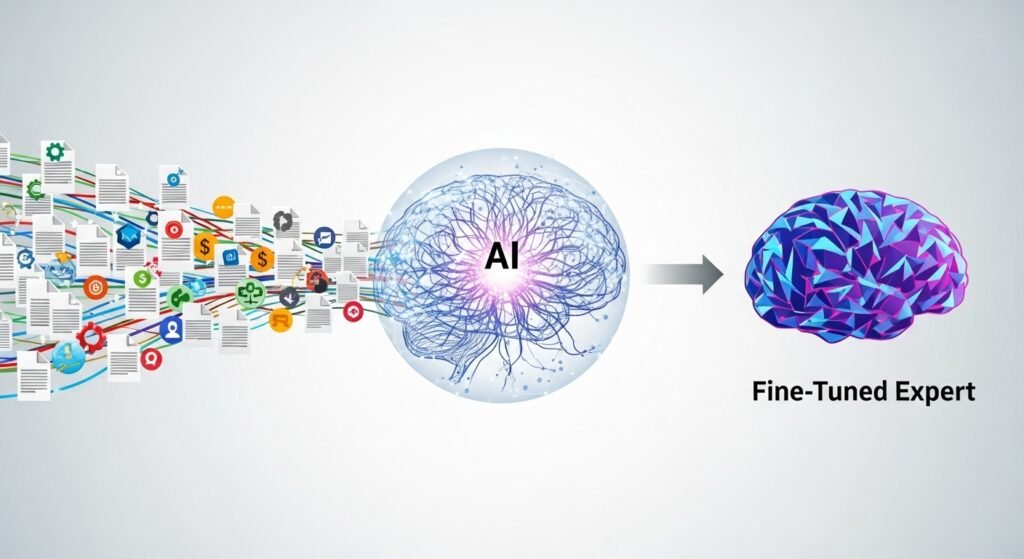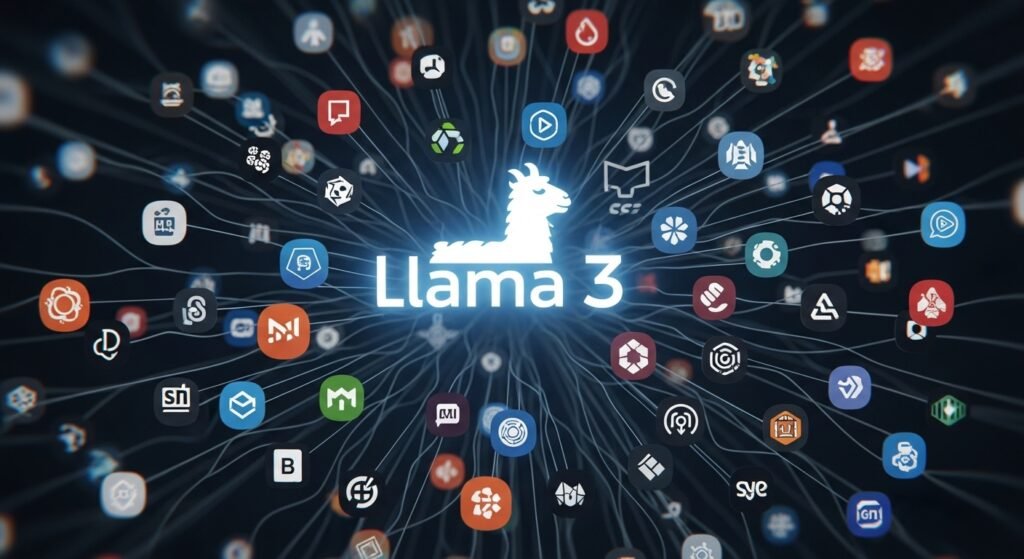In the world of artificial intelligence, two titans are shaping the future, but in fundamentally different ways. The GPT-4o vs Meta AI (Llama 3) showdown is more than a comparison of features; it’s a battle between two core philosophies. This isn’t the first time we’ve seen a great AI divide; it represents a critical choice between a polished, all-in-one service and a powerful, community-driven open-source model. This guide will provide the definitive, hands-on analysis to help you decide which is right for you.
Executive Summary: Polished Service vs. Open-Source Power
In the direct comparison of GPT-4o vs Meta AI (Llama 3), the best choice depends entirely on your need for convenience versus control. GPT-4o is the superior option for users who want the most advanced, easy-to-use, and versatile real-time multimodal AI assistant as a ready-made service. Llama 3 is the undisputed champion for developers and businesses who need a powerful, customizable, and transparent open-source model.
This strategic difference is the most important factor. OpenAI’s GPT-4o offers a seamless, polished experience out of the box. In contrast, Meta AI’s Llama 3 provides the building blocks for users to create their own specialized AI. This article will dissect these two paths with practical tests to guide your decision.
The Core Philosophies: “Model as a Service” vs. “Open-Source Power”

To make a meaningful choice in the GPT-4o vs Meta AI (Llama 3) comparison, you have to understand the “deal” you’re making. You are choosing between a convenient, ready-made service and a powerful, raw material that you can shape yourself. This choice between a closed and open ecosystem is the most important one you will make.
OpenAI’s GPT-4o: The Polished, All-in-One Conversational AI
GPT-4o is offered as a premium, closed-source “Model as a Service.” This means you access its incredible capabilities through a polished web interface or a developer API. You don’t have to worry about hardware, software updates, or maintenance. You simply pay for access to a state-of-the-art tool that just works.
The value of the GPT-4o service is its convenience, reliability, and access to cutting-edge features like real-time voice and vision capabilities without any technical overhead. It’s a powerful AI appliance.
Meta’s Llama 3: The People’s Champion of Customization and Control
Llama 3 is a powerful, open-source model that gives you complete control. This means developers can download the model’s weights, run them on their own private servers, and fine-tune them with their own data. This approach offers maximum privacy, customization, and transparency.
The value of the Llama 3 model is ownership. It’s the perfect choice for those who want to build a truly unique and specialized AI application and have full control over their data and deployment, free from reliance on a third-party service. It’s a powerful AI engine.
At a Glance: Key Specification Showdown
Here’s how these two philosophies translate to their core offerings.
| Feature | GPT-4o | Meta AI (Llama 3) |
| Access Method | API / Web Application | Downloadable Weights |
| Cost Structure | Pay-per-use / Subscription | Free (Requires compute/hardware costs) |
| Core Strength | Seamless Real-time Multimodality | Deep Customization & Fine-tuning |
| Status | Closed-source | Open-source |
This strategic choice between a managed service and an open platform is a defining feature of the current AI landscape, with different enterprise AI models also falling into these different categories.
Showdown 1: The Multimodal & Real-Time Test (GPT-4o’s Home Turf)

GPT-4o’s biggest claim to fame is its native multimodality. Unlike other models that bolt-on vision and audio capabilities, GPT-4o was built from the ground up to process text, vision, and audio as a single, unified system. This showdown tests if that architectural advantage translates to a superior user experience in real-time scenarios.
The Live Vision Test
- The Task: We used a smartphone camera to show both models a live video feed of a desk. We asked: “Describe what you see and tell me what the person might be doing.”
- GPT-4o’s Performance: GPT-4o responded almost instantly with a fluid, conversational description. “I see a desk with a laptop, which suggests someone is working. There’s also a coffee cup, so they might be starting their day or taking a break.” The response was incredibly fast, with near-zero latency, feeling like a true observation.
- Meta AI (Llama 3)’s Performance: The Meta AI interface required us to first capture a photo and then upload it. After a noticeable processing delay, it accurately described the items on the desk. However, the process was not real-time and felt like analyzing a static image rather than observing a live scene.
Verdict: For live, interactive vision capabilities, GPT-4o is the decisive winner. Its speed and seamless processing create a much more natural and powerful experience.
The Voice Conversation Test
- The Task: We initiated a voice assistant conversation with both models, asking them to tell us a story. Partway through a sentence, we interrupted with a question: “Wait, what color was the hero’s horse?”
- GPT-4o’s Performance: GPT-4o handled the interruption perfectly. It immediately stopped its story, answered the question (“The horse was a brilliant white”), and then seamlessly resumed the narrative exactly where it left off. The interaction felt natural and human-like.
- Meta AI (Llama 3)’s Performance: The voice assistant powered by Meta AI was less fluid. It finished its current sentence before acknowledging our question, and there was a distinct pause before it responded. The back-and-forth did not feel as natural or truly conversational.
Verdict: GPT-4o wins again. Its native multimodal architecture allows it to handle interruptions and maintain context in a way that is far superior for building a truly interactive conversational AI.
The Verdict
For any application that requires seamless, low-latency, real-time interaction with voice and vision, GPT-4o has a significant and undeniable architectural advantage. While Llama 3 can process images, GPT-4o’s ability to do so conversationally and in real-time places it in a different league. This focus on a premium user experience is a key factor when comparing it to other advanced AI subscriptions.
Showdown 2: The Open-Source Advantage (Llama 3’s Kingdom)
After seeing GPT-4o’s polished, real-time performance, this showdown tests the fundamental superpower of Meta AI (Llama 3): its open-source nature. This isn’t about the out-of-the-box experience, but about the limitless potential that comes with having control over the model itself.
The Fine-Tuning Test

- The Task: We simulated a common business need: creating an AI assistant that is an expert in a company’s specific, private data.
- Llama 3’s Advantage: With Llama 3, a company can take the powerful pre-trained model and fine-tune it on thousands of its own internal documents—be it legal contracts, customer support logs, or engineering specs. This process creates a new, proprietary model that is a true expert in that company’s specific domain. This specialized model can then be run on private servers, ensuring maximum data security.
- GPT-4o’s Disadvantage: As a closed-source Model as a Service, this is not possible with GPT-4o. You cannot download the model or retrain it on your private data. While you can provide context in a prompt using few-shot learning, you cannot fundamentally change the model into a specialized expert.
Verdict: For any user who needs to create a truly specialized AI with deep domain knowledge, Llama 3 is the decisive winner. Its open-source nature provides a level of customization that closed-source models simply cannot offer.
The Community Test

- The Task: We searched for a ready-made, specialized model for a niche but common developer task: converting natural language questions into SQL queries.
- Llama 3’s Advantage: On platforms like Hugging Face, we instantly found dozens of Llama 3 models already fine-tuned by the community for “Text-to-SQL.” We could download and use a powerful, specialized model for free, leveraging the collective work of a massive global community.
- GPT-4o’s Disadvantage: With GPT-4o, while it is excellent at writing SQL, you are always using the same generalist model. You can find specialized “GPTs” in the GPT Store, but they are still wrappers around the same core AI, not fundamentally different, community-trained models.
Verdict: Llama 3 wins again. Its vast and active community is a massive force multiplier, providing a rich ecosystem of specialized tools and models that accelerate development and solve niche problems. This is a recurring theme in any open-source vs API comparison.
The Verdict
Llama 3’s open-source nature is not just a feature; it’s a massive strategic advantage for anyone who needs control, customization, privacy, or wants to leverage the power of a global developer community. While GPT-4o offers a perfect, polished service, Llama 3 provides a powerful engine that you can rebuild and reshape to fit your exact needs.
Showdown 3: The Head-to-Head Gauntlet
After exploring their unique philosophical advantages, we put both GPT-4o vs Meta AI (Llama 3) through a gauntlet of common, everyday tasks. This is a test of raw performance to see how they stack up on the core capabilities that users rely on most.
The Code Generation Test
- The Task: We gave both models a practical programming challenge: “Write a Python script that scrapes the titles of the top 5 articles from a news website’s homepage using the ‘requests’ and ‘BeautifulSoup’ libraries.”
- The Result: This was a dead heat. Both GPT-4o and Llama 3 produced clean, efficient, and perfectly functional Python code almost instantly. They both correctly identified the necessary HTML tags and structured the code with best practices.
Verdict: For standard code generation, it’s a tie. Both models are at the absolute top of their class and are exceptionally reliable coding partners for everyday developer tasks.
The Creative Writing Test
- The Task: We tested their Natural Language Generation (NLG) with a nuanced creative prompt: “Write a short, imaginative product description for a fictional product: ‘a candle that smells like a freshly opened book.'”
- Llama 3’s Response: Llama 3 produced a very good description: “Introducing ‘The Library.’ This candle captures the scent of fresh paper and old vanilla. Light it to bring the quiet, comforting smell of a bookstore into your home. Perfect for readers and quiet evenings.”
- GPT-4o’s Response: GPT-4o’s description was more evocative and polished: “Unlock the first page. Our ‘First Edition’ candle is an homage to that magical scent of a brand new story. Notes of crisp paper, a hint of aged vanilla, and the subtle fragrance of ink on the page. Light it, and let the adventure begin.”
Verdict: We give a slight edge to GPT-4o. While both are excellent, GPT-4o’s response demonstrates a higher level of creative polish and marketing flair. It often excels in tasks where a sophisticated and human-like nuance is required, a key consideration for enterprise AI writing tasks.
The Verdict
On a level playing field, both models are technical powerhouses, tying in our coding test. However, GPT-4o demonstrates a slight but noticeable advantage in creative writing tasks where polish, flair, and a distinctively human touch are important.
The Final Verdict: Which AI Should You Use?

After a series of demanding showdowns, the verdict in the GPT-4o vs Meta AI (Llama 3) debate is not about which model is “better,” but which philosophy is right for you. It is a strategic choice between the ultimate convenience of a polished service and the ultimate control of an open-source powerhouse.
Choose GPT-4o if…
…you need the most advanced, easy-to-use, and versatile multimodal assistant and prefer a managed API.
If you want an AI that works seamlessly out of the box with incredible real-time voice and vision capabilities, GPT-4o is the undisputed champion. Its victories in our Multimodal Showdown and its edge in creative polish make it the superior choice for users who value a frictionless user experience.
- Personas: Content Creators, Businesses needing a ready-made solution, and General Users who want the most advanced AI assistant.
Choose Meta AI (Llama 3) if…
…you are a developer, researcher, or startup who needs to build a custom, specialized AI and wants full control over your model and data.
If your goal is to create a unique AI application, Llama 3 is the superior choice. Its open-source nature, as demonstrated in our tests, provides an unmatched level of flexibility for fine-tuning and customization. The massive community and full data privacy make it the ideal foundation for building the next generation of AI tools, a key factor in any AI face-off.
- Personas: Developers, Researchers, Startups, and Privacy-focused Businesses.
Frequently Asked Questions (FAQs)
Is Llama 3 completely free to use?
Yes, the Llama 3 model itself is free to download and use for both research and commercial purposes. However, you are responsible for the hardware and compute costs required to run it.
Which model is “smarter” based on benchmarks?
They are extremely close. On key industry benchmarks like MMLU (general knowledge) and HumanEval (coding), they trade blows for the top spot. Neither model has a decisive, across-the-board lead in raw intelligence.
Can Llama 3 understand images and voice like GPT-4o?
Not natively. Llama 3 is primarily a text-based model. While there are open-source projects to add vision capabilities, it does not have the seamless, built-in, real-time voice and vision processing that defines GPT-4o.
What does “open-source” really mean for an AI model?
It means you can download the model’s weights (its “brain”), inspect them, modify them through fine-tuning, and run them on your own private hardware. This gives you complete control, privacy, and ownership over your AI application.
Conclusion: Service or Engine?
The ultimate AI showdown between GPT-4o vs Meta AI (Llama 3) ends with a clear choice that defines your entire AI strategy. Are you looking for a polished, cutting-edge service that is always ready to use? Or are you looking for a powerful, open engine to build your own custom creations?
GPT-4o is the perfected AI appliance. Llama 3 is the world-class AI engine. Unlike other battles between the titans of AI, your choice here is less about features and more about your fundamental need for convenience versus control. Once you decide which is more important, your answer is clear.
Which philosophy do you prefer for your projects—a polished service or an open engine? Share your choice in the comments below!

